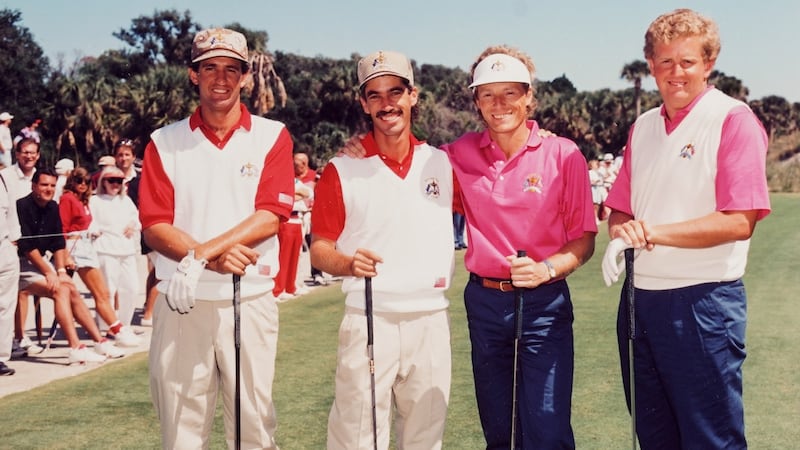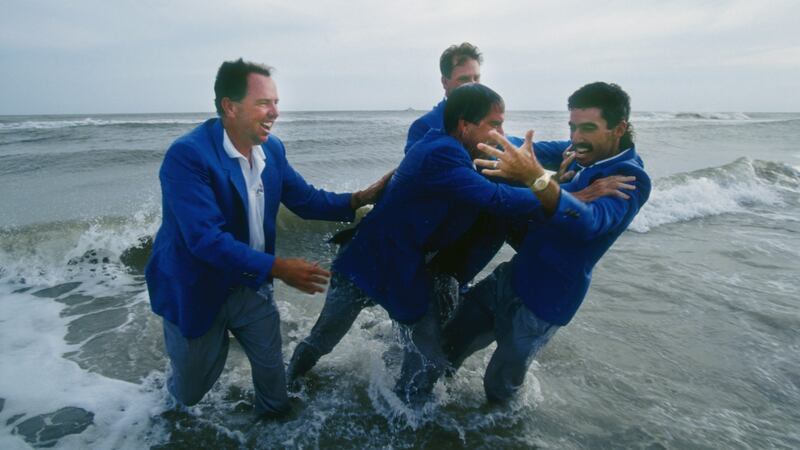The 1991 Ryder Cup was never destined to end well for Europe. The bad blood began before a ball had even been struck at the Kiawah Island course in South Carolina. At the pre-tournament gala dinner, the hosts broadcast a 15-minute video showing the history of the competition. It was so one-sided in favour of the Americans that Ken Schofield, the boss of the European Tour, nearly walked out in protest. "The film was a joke," reflected Europe captain Bernard Gallacher. "All they showed were Americans hitting shots."
There was more to come. A local radio DJ revealed the phone numbers of the European players’ hotel rooms, encouraging listeners to call them in the early hours of the morning before the event. The “Wake Up the Enemy” campaign was a bit juvenile, but it helped set the mood.
The War on the Shore was never far from controversy. On day one tensions grew between Seve Ballesteros and Paul Azinger in the opening foursomes session. Ballesteros's partner José María Olazábal noticed that Azinger and Chip Beck had illegally changed their ball on the seventh hole, leading to a 15-minute discussion. Eventually the dispute ended, but Ballesteros had the bit between his teeth. Having trailed by three holes, the Spaniards rallied and claimed a 2&1 victory. It was just as well for Europe. It was the only point the visitors picked up in the first session as USA took a 3-1 lead.

Ballesteros and Olazabal beat the same partnership in the afternoon fourballs, as Europe fought back to trail by just a point overnight. The Spaniards also won on the Saturday morning but, with the rest of their team-mates struggling, the Ryder Cup was in danger of slipping away. USA held a 7½-4½ lead going into the Saturday afternoon.
Some of the Americans seemed to be swept up on a tide of patriotism and emotion, with Corey Pavin and Steve Pate playing the Saturday fourballs wearing camouflaged caps in a tribute to the Gulf War. It wasn't to be Pate's only contentious moment over the weekend.
He was involved in a car crash on the way to the tournament, but recovered sufficiently to pair up with Pavin on the Saturday. The duo were beaten by Bernhard Langer and Colin Montgomerie, who was making his debut in the Ryder Cup. Europe took the afternoon session 3½-½, with Ballesteros and Olazábal claiming a half in a classic match with Payne Stewart and Fred Couples, as the teams went into the final day tied at 8-8.
Before the singles matches teed off on Sunday, the US captain Dave Stockton announced that Pate would not be able to play due to his injuries from the crash. Pate was not pulled until after the draw, which pitted him against Ballesteros, had been made. His match was automatically halved and Europe captain Gallacher decided that David Gilford would have to sit out the day. Pate had played on the Saturday, so European suspicions were aroused about his sudden loss of fitness. Many felt Ballesteros would have beaten Pate, with Gilford capable of seeing off the out-of-form Wayne Levi. Would the half-point claimed by the withdrawal prove crucial?
There is nothing like the final day of a Ryder Cup for gut-wrenching tension. Fans study the scoreboard meticulously for hours on end, allowing themselves brief moments of hope when a blob of blue or red is added, before descending into despondency when the other colour starts to dominate. By the end of the 12 singles matches – or 11 in 1991 – it feels like you’ve been to hell and back.
It is even worse for the players. Nick Faldo said that every part of his body was shaking during his pivotal singles match against Curtis Strange in 1995. Mark Calcavecchia was in an even worse state after his singles match against Montgomerie at Kiawah Island. The American fell apart towards the end of his round. He was four up with four to play, but then everything began to unravel. Finishing triple-bogey, bogey, triple-bogey, bogey, Calcavecchia halved his match, needed treatment after hyperventilating and walked to the beach in tears, fearing that his collapse had cost his team the cup.
Montgomerie's half and wins for Faldo and David Feherty gave Europe the early advantage on the final day. But, with a chilling inevitability, the 29th Ryder Cup would come down to the last match. With Europe trailing 14-13 and Langer two down against Hale Irwin with just four holes to play, the Americans had one hand on the trophy.
Langer needed to win his match to keep the cup in Europe. He gave it everything over those last four holes. He won the 15th, halved the 16th and levelled the match at the 17th, sinking putts that would have tested anyone under that pressure, let alone a man using a strange grip to solve his latest putting crisis. Wrapping his right hand around a left arm and putter shaft that were linked together, Langer managed to prolong the agony for everyone involved. The 1991 Ryder Cup would be decided on the final hole of the final match of the weekend.

Just in case there had not been enough to talk about, another portion of controversy followed. Needing to win the last hole to retain the cup, Langer hit the fairway with his tee shot. What happened to Irwin’s tee shot remains something of a mystery 30 years later. He pulled his shot towards the dunes, some 40 yards left of the fairway, but apparently it hit a spectator and had a lucky bounce. Somehow his ball ended up on the fringe of the rough, sitting up nicely.
European doubts remain to this day. “One thing I never understood was what happened when Hale Irwin drove off,” said Langer years later. “It looked like his ball was going into the sand dunes, but when we got down there it was on the edge of the fairway.”
Whether Irwin received a helping hand or not, the job was far from done. He pushed his second shot and was unable to get up and down. Langer knew a par would win the match and secure the Ryder Cup. His first putt looked good but trickled on, leaving him a six-foot putt for his par. It would be hard enough under normal circumstances, but a significant spike mark on the line of Langer’s putt left him with a dilemma.
Ian Woosnam explained the situation in his autobiography, Woosie: "He faced a decision: did he putt over it, or did he putt softly round the mark and allow the ball to take the break? We sensed the problem from the edge of the green and we all agreed he was right to try and putt around the mark."
Langer missed, sliding his ball past the hole. He bent his knees and opened his mouth in anguish as the putt brushed the right lip of the hole. Cruelly, he would be remembered as the man who missed a putt that lost the Ryder Cup. That is true, but very few other players would have fought hard enough to get into that position.
There were tears in the team room afterwards, but Langer was a fighter. He won the German Masters the very next week. He could have hidden away, wallowed and used that Ryder Cup moment as an excuse to dissolve. But the resolve that got Langer into that position on the 18th was the reason he rebounded so quickly. It’s little wonder that he made such a good captain in 2004. His record victory at Oakland Hills was a fine way for the German to exit the Ryder Cup stage. – Guardian












